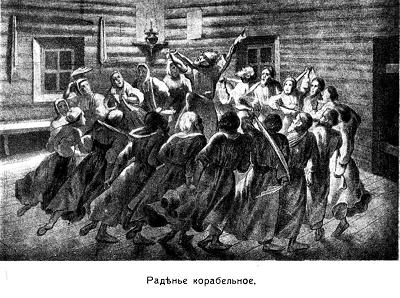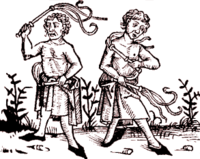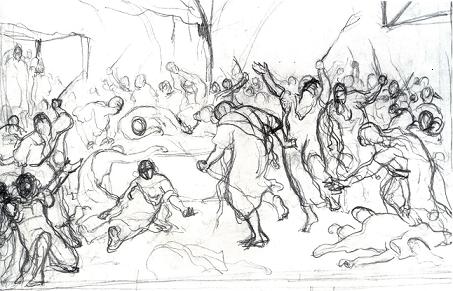It looks like you're using an Ad Blocker.
Please white-list or disable AboveTopSecret.com in your ad-blocking tool.
Thank you.
Some features of ATS will be disabled while you continue to use an ad-blocker.
8
share:
Salvation through Sin:
The Secret World of Russia’s Khlysty Sect

I recently read a bit about a cultish sect known as the Khlysty (Христы) that was active in Russia from the seventeenth through the early twentieth centuries. I figure it might be of interest to some people here—the story of the Khlysty is one of secrecy, ambiguity, forbidden spiritual doctrines and extreme philosophical stances.
Banned by authorities and the source of scandalous rumor, the Khlysty survived in a secretive, underground world of strange, antinomian rituals. Believing that one needed to plumb the depths of sin in order to gain salvation, the Khlysty were akin to many “left-hand path” groups throughout religious history in that they fused forbidden and sexual behavior with spirituality. Comparisons to Vamachara Tantra, Tantric Buddhism, and Sabbatean-Frankist Judaism, as well as certain antinomian groups throughout Christian history such as the medieval Brotherhood of the Free Spirit, certainly suggest themselves.

The Early Years
The origins of the Khlysty are placed in 17th-century Siberia, when a peasant and army deserter, Danilo Filipov, declared that he was a living God, and that there was no inherent barrier between the human and the divine. The word "Khlysty" is usually seen to refer to the whips that sect members used upon themselves in their rituals. (More on this below.)
Filipov declared his follower Ivan Suslov as his Christ. The Russian authorities, however, were unconvinced—and unamused. Suslov was crucified and hung on the wall of the Kremlin in Russia, while Filipov was exiled to Siberia. According to the Khlysts, the body of Suslov rose from the dead only to be tortured, flayed, and crucified again, before rising yet again and ascending to heaven in 1718.
The Radaev Line
In its early days, the cult stressed asceticism and self-denial. Alcohol, marriage, and swearing were forbidden, and children (the product of sex) were called “sins.” People could marry, but the women were known as “spiritual wives” and no sex was allowed.
This would change with the advent of a Khlyst cult leader known as Radaev and his followers, or “line.” Radaev taught the following doctrines:
-Chastity was a sin because it was rooted in pride.
-Radaev was animated by God’s will, not his own base desire, and if he wished to sleep with a woman she must agree, as it represented God’s will.
-Generally, Khlysts should live daily, sex-free lives between rituals, when they would meet in groups.

The Secret Khlysty Meetings
Khlysty were organized in small, secret groups known as “arks.” Each ark was led by a “Pilot” and later other positions (such as the “Mother of God,” or highest ranking female) were introduced. Official estimates of membership in the banned group ranged from 40,000 to 120,000, although such figures are guesswork. Because the groups were illegal, members were encouraged to be especially devout and active in their local Orthodox churches, to maintain secrecy and deflect possible suspicions.
Khylsty meetings were held in forest clearings and secret dugouts beneath barns. The meetings would begin with singing and drumming around a bonfire. The members began to dance, seeking a state of mystical transport they called radeinie, or “frenzy,” which was seen as necessary for possession by the Holy Spirit. They would whip themselves with birch-branches and begin to speak ecstatically in what they called “the Language of Jerusalem.” As the sense of divine intoxication mounted, the ritual reached a creshendo when the group would collapse into indiscriminate sexual orgy. This was called “using sin to drive out sin,” which (interestingly) reminds me of the Tantric Buddhist description of left-handed (sexual) Tantra as “using poison to cure poison.”

Other Beliefs
In addition to their “scandalous” sexual behavior, the Khlysty held some other unusual view. They believed that man could be united with the divine in this lifetime (another belief shared with Tantrics and indeed mystics of all stripes). They also believed Christ was constantly reincarnated and in each era walked the earth somewhere as a humble peasant. In other words, they believed that given moment, somewhere, the current incarnation of Christ walking in the body of a poor man. Sin was said to be necessary for salvation, because without sin there could be no repentance, and without repentance there could be no salvation.
Rasputin and the Khlysty
Gregori Rasputin, the wandering monk who ingratiated himself with the Tsar’s family in the final years before the Russian Revolution, was rumored to have been involved with the Khlysty in his early years in Siberia, but no conclusive proof was ever unearthed of this. Certainly his words and deeds evidenced Khlysty themes, such as the intertwining of sexuality and religion, and his use of a mysterious underground chapel while in Siberia. As a young man, Rasputin wandered about seeking knowledge from many religious teachers in Russia, and it is possible he had some contact with or was influenced by this group.

Sources
Much of the information for this came from Brian Moynahan’s excellent biography of Rasputin. Also of possible interest:
Wikipedia: Khlysts
The Khlysty Sect: Short articles
The Khlysty
Another article on the Khlysty
Possible topics for discussion
-What do you make of the sect’s philosophy of “salavation through sin”? Is this philosophically valid, evil incarnate, or somewhere in between?
-Should governments take steps to forbid sects like this?
-There are many possible parallels with other antinomian sects and movements like Tantra, as described above. Are these just coincidence…or are they all linked in some way?
-Do hints of this philosophy linger on in today’s spiritual world?
The Secret World of Russia’s Khlysty Sect

I recently read a bit about a cultish sect known as the Khlysty (Христы) that was active in Russia from the seventeenth through the early twentieth centuries. I figure it might be of interest to some people here—the story of the Khlysty is one of secrecy, ambiguity, forbidden spiritual doctrines and extreme philosophical stances.
Banned by authorities and the source of scandalous rumor, the Khlysty survived in a secretive, underground world of strange, antinomian rituals. Believing that one needed to plumb the depths of sin in order to gain salvation, the Khlysty were akin to many “left-hand path” groups throughout religious history in that they fused forbidden and sexual behavior with spirituality. Comparisons to Vamachara Tantra, Tantric Buddhism, and Sabbatean-Frankist Judaism, as well as certain antinomian groups throughout Christian history such as the medieval Brotherhood of the Free Spirit, certainly suggest themselves.

The Early Years
The origins of the Khlysty are placed in 17th-century Siberia, when a peasant and army deserter, Danilo Filipov, declared that he was a living God, and that there was no inherent barrier between the human and the divine. The word "Khlysty" is usually seen to refer to the whips that sect members used upon themselves in their rituals. (More on this below.)
Filipov declared his follower Ivan Suslov as his Christ. The Russian authorities, however, were unconvinced—and unamused. Suslov was crucified and hung on the wall of the Kremlin in Russia, while Filipov was exiled to Siberia. According to the Khlysts, the body of Suslov rose from the dead only to be tortured, flayed, and crucified again, before rising yet again and ascending to heaven in 1718.
The Radaev Line
In its early days, the cult stressed asceticism and self-denial. Alcohol, marriage, and swearing were forbidden, and children (the product of sex) were called “sins.” People could marry, but the women were known as “spiritual wives” and no sex was allowed.
This would change with the advent of a Khlyst cult leader known as Radaev and his followers, or “line.” Radaev taught the following doctrines:
-Chastity was a sin because it was rooted in pride.
-Radaev was animated by God’s will, not his own base desire, and if he wished to sleep with a woman she must agree, as it represented God’s will.
-Generally, Khlysts should live daily, sex-free lives between rituals, when they would meet in groups.

The Secret Khlysty Meetings
Khlysty were organized in small, secret groups known as “arks.” Each ark was led by a “Pilot” and later other positions (such as the “Mother of God,” or highest ranking female) were introduced. Official estimates of membership in the banned group ranged from 40,000 to 120,000, although such figures are guesswork. Because the groups were illegal, members were encouraged to be especially devout and active in their local Orthodox churches, to maintain secrecy and deflect possible suspicions.
Khylsty meetings were held in forest clearings and secret dugouts beneath barns. The meetings would begin with singing and drumming around a bonfire. The members began to dance, seeking a state of mystical transport they called radeinie, or “frenzy,” which was seen as necessary for possession by the Holy Spirit. They would whip themselves with birch-branches and begin to speak ecstatically in what they called “the Language of Jerusalem.” As the sense of divine intoxication mounted, the ritual reached a creshendo when the group would collapse into indiscriminate sexual orgy. This was called “using sin to drive out sin,” which (interestingly) reminds me of the Tantric Buddhist description of left-handed (sexual) Tantra as “using poison to cure poison.”

Other Beliefs
In addition to their “scandalous” sexual behavior, the Khlysty held some other unusual view. They believed that man could be united with the divine in this lifetime (another belief shared with Tantrics and indeed mystics of all stripes). They also believed Christ was constantly reincarnated and in each era walked the earth somewhere as a humble peasant. In other words, they believed that given moment, somewhere, the current incarnation of Christ walking in the body of a poor man. Sin was said to be necessary for salvation, because without sin there could be no repentance, and without repentance there could be no salvation.
Rasputin and the Khlysty
Gregori Rasputin, the wandering monk who ingratiated himself with the Tsar’s family in the final years before the Russian Revolution, was rumored to have been involved with the Khlysty in his early years in Siberia, but no conclusive proof was ever unearthed of this. Certainly his words and deeds evidenced Khlysty themes, such as the intertwining of sexuality and religion, and his use of a mysterious underground chapel while in Siberia. As a young man, Rasputin wandered about seeking knowledge from many religious teachers in Russia, and it is possible he had some contact with or was influenced by this group.

Sources
Much of the information for this came from Brian Moynahan’s excellent biography of Rasputin. Also of possible interest:
Wikipedia: Khlysts
The Khlysty Sect: Short articles
The Khlysty
Another article on the Khlysty
Possible topics for discussion
-What do you make of the sect’s philosophy of “salavation through sin”? Is this philosophically valid, evil incarnate, or somewhere in between?
-Should governments take steps to forbid sects like this?
-There are many possible parallels with other antinomian sects and movements like Tantra, as described above. Are these just coincidence…or are they all linked in some way?
-Do hints of this philosophy linger on in today’s spiritual world?
edit on 12/15/11 by silent thunder because: (no reason given)
Ok, this explains something about a siberian woman i've met, who claims to command an army of spirits and talks up the tantric side of spirituality,
but in reality projects a sickening energy. Thanks op, seriously.
Possible topics for discussion
-What do you make of the sect’s philosophy of “salavation through sin”? Is this philosophically valid, evil incarnate, or somewhere in between?
I guess one would first have to ask……does sin exist in the first place?
So the answer to this question would first depend on your religious or spiritual beliefs. One could argue that the embracing the carnal could be likened to indulging the ego and therefore perpetuating the cycle of birth, death and rebirth. But then the groups motivations for these behaviors are not purely ‘pleasure for the sake of pleasure’
This is a tricky one. Philosophically though, there isn't much that isn't valid
-Should governments take steps to forbid sects like this?
Should the government ban anything in which involves consenting adults and zero harm?
-There are many possible parallels with other antinomian sects and movements like Tantra, as described above. Are these just coincidence…or are they all linked in some way?
This question probably deserves a much more detailed answer, but unfortunately it’s getting late in Australia
Every religion or belief system has some element of the truth to it, and it’s no surprise that after 1000’s of years of repression, groups such as these have emerged, for as much as one intrinsically feels that indulgence is not the way to ‘salvation’, it is no more likely that repression is either
-Do hints of this philosophy linger on in today’s spiritual world?
Anton Lavey’s Church of Satan initially sprang to mind, but the motivations for indulging in this sought of behavior seem on the surface to differ greatly between the two
edit on 15/12/2011 by 1littlewolf because: (no reason given)
Interesting topic.
The habit of going into a dugout, building fires, and drumming reminds me of Native American sweat lodges and Siberian Shamanism, which are distantly related. Obviously if these people were in Siberia, influence from shamanism would be understandable. The tantric elements might also be influence from Tibetan and Mongol Buddhism, another religious zone that borders on Siberia.
The habit of going into a dugout, building fires, and drumming reminds me of Native American sweat lodges and Siberian Shamanism, which are distantly related. Obviously if these people were in Siberia, influence from shamanism would be understandable. The tantric elements might also be influence from Tibetan and Mongol Buddhism, another religious zone that borders on Siberia.
new topics
-
Electrical tricks for saving money
Education and Media: 2 hours ago -
VP's Secret Service agent brawls with other agents at Andrews
Mainstream News: 3 hours ago -
Sunak spinning the sickness figures
Other Current Events: 4 hours ago -
Nearly 70% Of Americans Want Talks To End War In Ukraine
Political Issues: 4 hours ago -
Late Night with the Devil - a really good unusual modern horror film.
Movies: 6 hours ago -
Cats Used as Live Bait to Train Ferocious Pitbulls in Illegal NYC Dogfighting
Social Issues and Civil Unrest: 7 hours ago -
The Good News According to Jesus - Episode 1
Religion, Faith, And Theology: 9 hours ago -
HORRIBLE !! Russian Soldier Drinking Own Urine To Survive In Battle
World War Three: 11 hours ago
top topics
-
Cats Used as Live Bait to Train Ferocious Pitbulls in Illegal NYC Dogfighting
Social Issues and Civil Unrest: 7 hours ago, 8 flags -
Florida man's trip overseas ends in shock over $143,000 T-Mobile phone bill
Social Issues and Civil Unrest: 14 hours ago, 8 flags -
VP's Secret Service agent brawls with other agents at Andrews
Mainstream News: 3 hours ago, 8 flags -
Former Labour minister Frank Field dies aged 81
People: 17 hours ago, 4 flags -
HORRIBLE !! Russian Soldier Drinking Own Urine To Survive In Battle
World War Three: 11 hours ago, 3 flags -
Nearly 70% Of Americans Want Talks To End War In Ukraine
Political Issues: 4 hours ago, 3 flags -
Sunak spinning the sickness figures
Other Current Events: 4 hours ago, 3 flags -
Bobiverse
Fantasy & Science Fiction: 14 hours ago, 3 flags -
Electrical tricks for saving money
Education and Media: 2 hours ago, 3 flags -
Late Night with the Devil - a really good unusual modern horror film.
Movies: 6 hours ago, 2 flags
8
